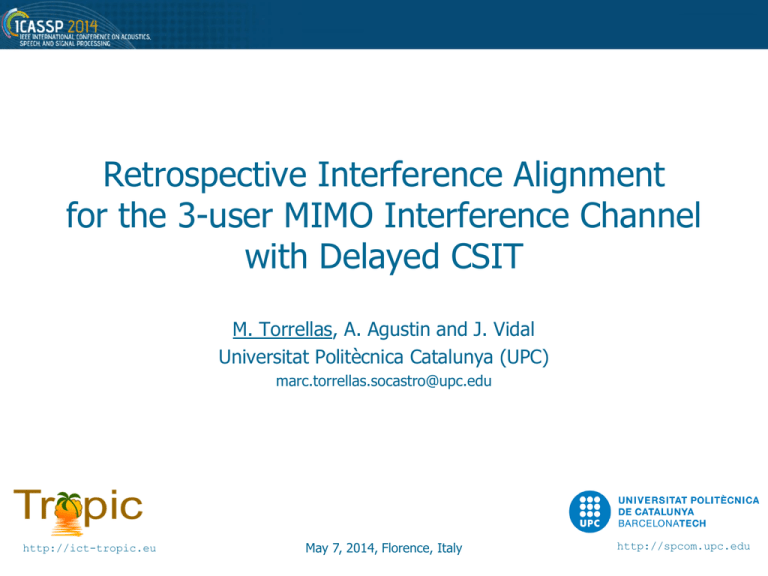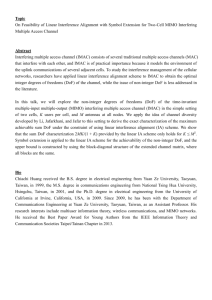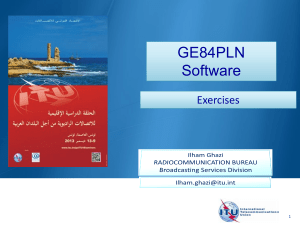Retrospective Interference Alignment for the 3-user MIMO Interference Channel with Delayed CSIT
advertisement

Retrospective Interference Alignment for the 3-user MIMO Interference Channel with Delayed CSIT M. Torrellas, A. Agustin and J. Vidal Universitat Politècnica Catalunya (UPC) marc.torrellas.socastro@upc.edu http://ict-tropic.eu May 7, 2014, Florence, Italy http://spcom.upc.edu Motivation Many works have shown that use of linear beamforming at transmitters and receivers can be used to manage interference in wireless networks. In the context of the interference channel (IC), Interference Alignment (IA) concepts provide each user half the cake but... at the cost of assuming perfect and instantaneous channel state information at the transmitter side (CSIT) What about feedback errors? And feedback delay? Maddah-Ali et al. (MAT) proposed the delayed CSIT framework in [MAT12], where completely outdated CSIT can be exploited for IA in the BC. This type of IA was subsequently denoted as Retrospective IA (RIA) and extended to the SISO IC. We extend those ideas to the MIMO IC case, and get insight into how additional antennas at each side impact the total degrees of freedom (DoF) of a network with delayed CSIT. [MAT12] M.A. Maddah-Ali and D. Tse, "Completely Stale Transmitter Channel State Information is Still Very Useful" IEEE Trans. Inf. Theory, June 2012 2 Summary 1. System model 2. Review of RIA for SISO 3. RIA for MIMO 4. Results 5. Conclusions 3 System Model Each transmitter delivers b symbols to its pair We consider two phases (W = W1 + W2) Interfering Sensing (IS) phase RIA phase All terminals are active during all phases Output at the j-th receiver, phase p, slot s : N 1 N M M b b 1 IS RIA W1 W2 N 1 4 System Model Let consider the signals received at user 1 along the first phase: desired interference We can group these signals as follows with 5 IA constraints and DoF This is written in general as NWp MWp MWp b NW MW b 1 b NW MW b b, W1 ,W2 Vi1 and Z j predetermined, only to be designed 2 Vi 6 System Model – CSIT definition Assuming full CSIR, each receiver does the following operation at the end of the IS phase: 1 Vj 1 1 Vj 1 U j , j 1 U j , j 1 : ZF filter preserving interference from tx i at rx j NW1 b NW1 : interference caused by tx i at rx j, with NW1 b b CSIT to be reported to tx i after the first phase: 7 Review of RIA for SISO [Maleki12] IS phase: all users transmit simultaneously with random i.i.d entries CSI report: acquisition of RIA phase: each user aims to align the transmitted signals at both rxs one easy solution This way the transmitted signals provide linear combinations of desired signals, while maintaining the rank of received interference [Maleki12] H. Maleki, S. Jafar, S. Shamai , "Retrospective interference alignment over interference networks", IEEE J. Sel. Topics Signal Process., Jun.2012 8 RIA for MIMO - Constraints Constraints that make the scheme reliable for any given antenna setting: 1. First phase ZF filters 2. Intersection subspace: 3. Receiver Space-Time dimensions: 4. Rank of desired signals after zero-forcing: 9 RIA for MIMO – Problem statement Overall, the problem is written as 10 RIA for MIMO – Solution For the range the optimal values are found to be with 11 Results The achievable DoF as a function of A: Many rx antennas, no need of CSIT C: [Abdoli13] Scaled SISO IC scheme D: [Vaze12] 2-user IC schemes [Abdoli13] M.J. Abdoli et al, "On the Degrees of Freedom of K -User SISO Interference and X Channels With Delayed CSIT" IEEE Trans. Inf. Theory, Oct. 2013 [Vaze12] C.S. Vaze et al, "The Degrees of Freedom Region and Interference Alignment for the MIMO Interference Channel with Delayed CSIT" , IEEE Trans. Inf. Theory, Jul. 2012 12 Results The achievable DoF as a function of A: Many rx antennas, no need of CSIT B: RIA for MIMO. Useful for N > M C: [Abdoli13] Scaled SISO IC scheme D: [Vaze12] 2-user IC schemes [TAV14] presented at ICASSP14 [Abdoli13] M.J. Abdoli et al, "On the Degrees of Freedom of K -User SISO Interference and X Channels With Delayed CSIT" IEEE Trans. Inf. Theory, Oct. 2013 [Vaze12] C.S. Vaze et al, "The Degrees of Freedom Region and Interference Alignment for the MIMO Interference Channel with Delayed CSIT" , IEEE Trans. Inf. Theory, Jul. 2012 [TAV14] M. Torrellas et al, "On the Degrees of freedom of the K -user MISO Interference Channel with imperfect delayed CSIT" IEEE ICASSP, May 2014 13 Conclusions We extend the RIA scheme of Maleki et al. for the MIMO case Our approach is based on formulating a maximization problem, valid for any antenna setting (M,N) New DoF inner bounds are provided as a function of the ratio among tx/rx antennas and compared with other approaches Future work: MIMO or K-user extension for other schemes using similar tools, improve outer bounds for the MIMO IC with delayed CSIT 14 Thanks for your attention M. Torrellas, A. Agustin and J. Vidal Universitat Politècnica Catalunya (UPC) marc.torrellas.socastro@upc.edu http://ict-tropic.eu May 7, 2014, Florence, Italy http://spcom.upc.edu Backup slides http://ict-tropic.eu May 7, 2014, Florence, Italy http://spcom.upc.edu 17 18





